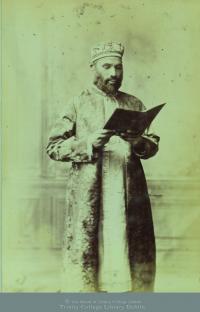Integration: ‘Seeing a vision in a pool of ink’: ‘The Mir’ of India in Ireland
Published in 18th–19th - Century History, Features, Issue 3 (May/June 2010), Volume 18
Mir Aulad, Professor of Arabic, Hindustani and Persian at Trinity College, Dublin, frequently attended formal events, including the annual Dublin Castle ball hosted by the lord lieutenant and the marchioness of Abercorn, in the traditional attire common to Northern India. (Trinity College, Dublin)
Mir Aulad remains a bit of an enigma, especially as his name and origins are subject to speculation. Sometimes spelt phonetically, ‘Meer Owlad Allee’ was from Oudh (now known as Audah), which had been one of the provinces of the Mughal Empire in India. Whilst this area was effectively a vassal of the British East India Company from 1801, Mir Aulad’s travels and education are indicative of the privileges of the area’s ruling Turko-Persian-Afghan class. This has led some commentators to suggest that he was of ‘Persian’ origin. Mir is a title, meaning ‘leader’, from the Arabic emir or prince. There is also some evidence to suggest that Mir Aulad had been in the employment of the king of Oudh for some years before moving to Dublin.
Trinity College created a department of Oriental Studies in the eighteenth century, with the aim of rivalling both Oxford and Cambridge. Included amongst some of Trinity’s most prominent early orientalists was William Ouseley. In 1855 Trinity College became the new centre for training, as appointments to the army and civil service were opened to the public. William Wright was appointed the first Professor of Arabic in 1855, resigning in 1861 to take up a position as keeper of Syrian Manuscripts at the British Library.
The testimonials of Mir Aulad were examined in early October 1861, and later that month he was appointed Professor of Arabic and Hindustani. His position, which was to be held for seven years, was renewable. He received a respectable fixed annual salary of £100, together with occasional fees from students attending additional lectures at the discretion of the provost and senior fellows. In 1866 Mir Aulad’s salary was raised to £150 per annum, and later in 1873 to £200 when he became Professor of Arabic, Hindustani and Persian. It seems that the professor’s appointment and move to Dublin came unexpectedly, as college furniture was sought and placed in his rooms to enable him to begin classes immediately. He eventually settled in 139 Leinster Road, Rathmines, and became immediately popular with both neighbours and colleagues alike. Mir Aulad, who occupied his chair for nearly 40 years, was instrumental in training civil servants who would go on to serve in his native India.
Mir Aulad was also a Dublin socialite, frequently gracing formal events in the traditional attire common to Northern India. Besides attending the annual Dublin Castle ball, hosted by the lord lieutenant and the marchioness of Abercorn, he was amongst the main local dignitaries regularly present when foreign parties came to Dublin. In September 1890 he was one of the main guides provided for the queen of Romania, showing her around Trinity College grounds.
A colourful character, ‘the Mir’ was also active in extracurricular activities at the university gymnasium. In 1872 he took part in the annual ‘assault of arms’—a fencing and martial skill competition—which was attended by more than 400 spectators, half of them women. The professor’s speciality was, perhaps unsurprisingly, the Indian clubs. These wooden clubs, which were popular in the nineteenth and twentieth centuries in the British Empire and Europe, were swung in certain patterns as part of an exercise routine. Mir Aulad, who was a small but ‘well-knit’ man, took the 16lb club and, according to reports, went through ‘a most difficult and long series of exercises without taking off his ordinary coat’. The audience marked its appreciation of his display with continuous and prolonged applause.
While Mir Aulad had been a Muslim, there is some speculation about whether he converted to Christianity or was merely lax in his practice. On the rare occasions when Islam was brought into public discussions, Mir Aulad defended the spirituality of the religion. His wife, an Englishwoman, never converted to Islam and instead was active in charitable work related to the parish church at Rathmines. Mir Aulad, who was also active in charitable affairs, was at the forefront of collecting money for the Turkish Relief Fund in 1878. This, however, was a collective effort and cannot be attributed to Mir Aulad’s religious solidarity with the Ottoman sultan. Indeed, whilst collecting money for the fund, the lord mayor of Dublin transcended religious adherence by reminding the Irish public that Sultan Abdul Majid had sent £1,000 out of his private purse for the relief of the Irish famine in 1846–7.
Mir Aulad died of a heart attack in 1898. Attempts to secure the attendance of a Muslim imam (priest) from London for the funeral failed, and Mir Aulad was eventually buried in a small corner of Mount Jerome cemetery. He was survived by his wife and son, and his famous character sporadically reappeared in popular culture. W.B. Yeats referred to Mir Aulad in his 1916 ‘Reveries over childhood and youth’. Talking about the importance of belief and conviction, Yeats tapped into prominent oriental discourse with the beautiful image of how the professor as a child had once ‘seen a vision in a pool of ink, a multitude of spirits singing in Arabic’. Mir Aulad’s legacy lived on. HI
Vivian Ibrahim is a postdoctoral researcher in Islamic Studies at University College Cork.‘Seeing a vision in a pool of ink’:
















